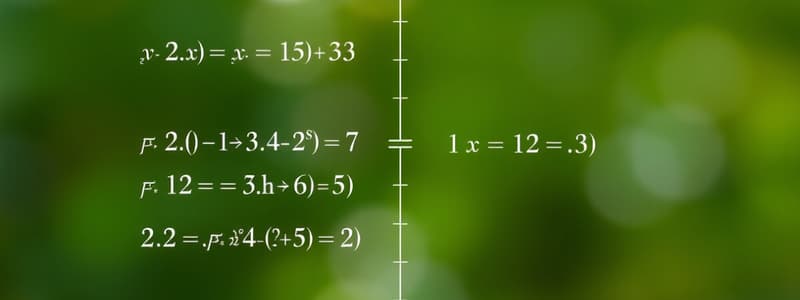Podcast
Questions and Answers
How do you find linear regression?
How do you find linear regression?
Go to stat, list, calc, and ensure stat diagnostics is on.
What defines a function?
What defines a function?
A relationship from one set (domain) to another set (range) with each element of the domain assigned to exactly one element of the range.
What is a one-to-one function?
What is a one-to-one function?
A function where each element of the range is paired with exactly one element of the domain.
Mutually exclusive events can occur at the same time.
Mutually exclusive events can occur at the same time.
What is an extraneous root?
What is an extraneous root?
What is the horizontal line test used for?
What is the horizontal line test used for?
What does the vertical line test determine?
What does the vertical line test determine?
Provide an example of set notation.
Provide an example of set notation.
What is interval notation for '5 greater than or equal to x'?
What is interval notation for '5 greater than or equal to x'?
How do you complete the square?
How do you complete the square?
What is the axis of symmetry formula?
What is the axis of symmetry formula?
State the quadratic formula.
State the quadratic formula.
What is the vertex form of a quadratic equation?
What is the vertex form of a quadratic equation?
What represents a horizontal shift in a function?
What represents a horizontal shift in a function?
What represents a vertical shift in a function?
What represents a vertical shift in a function?
How do you reflect a function over the x-axis?
How do you reflect a function over the x-axis?
How do you reflect a function over the y-axis?
How do you reflect a function over the y-axis?
What is vertical dilation?
What is vertical dilation?
How does horizontal dilation affect a function?
How does horizontal dilation affect a function?
An even function satisfies f(-x) = f(x).
An even function satisfies f(-x) = f(x).
An odd function satisfies f(-x) = -f(x).
An odd function satisfies f(-x) = -f(x).
What are conjugates?
What are conjugates?
What is the additive inverse?
What is the additive inverse?
What is the multiplicative inverse?
What is the multiplicative inverse?
How do you find the quadratic equation's a, b, and c with roots?
How do you find the quadratic equation's a, b, and c with roots?
What is the vertical asymptote equation?
What is the vertical asymptote equation?
What is the horizontal asymptote equation?
What is the horizontal asymptote equation?
What is the asymptote parent function?
What is the asymptote parent function?
How many horizontal asymptotes are there?
How many horizontal asymptotes are there?
How do you transform an asymptote?
How do you transform an asymptote?
What is the formula for exponential growth?
What is the formula for exponential growth?
What is the formula for exponential decay?
What is the formula for exponential decay?
What is the Compound Interest Formula?
What is the Compound Interest Formula?
What does Pe^rt represent?
What does Pe^rt represent?
What is the logarithm definition?
What is the logarithm definition?
If there is no base in the log, what is the base?
If there is no base in the log, what is the base?
What is the log product property?
What is the log product property?
What is the log power property?
What is the log power property?
What is the quotient property of logarithms?
What is the quotient property of logarithms?
What is the inverse of y = e^x?
What is the inverse of y = e^x?
State an alternative form for exponential growth with e.
State an alternative form for exponential growth with e.
State an alternative form for exponential decay with e.
State an alternative form for exponential decay with e.
What is a recursive sequence?
What is a recursive sequence?
Flashcards are hidden until you start studying
Study Notes
Linear Regression
- Use the 'stat' menu to find lists and calculate linear regression.
- Ensure 'stat diagnostic' is enabled for accurate results.
Function
- A function establishes a unique relationship between each element of the domain and the range.
- Examples of non-functions include any situation where an input produces multiple outputs.
One-to-One Function
- Each range element is uniquely paired with a domain element.
Mutually Exclusive Events
- Events that cannot occur simultaneously, e.g., rolling a 2 and 6 in one die throw.
Extraneous Root
- A solution that does not satisfy the original equation or problem.
Horizontal Line Test
- A method to check if a function is one-to-one by assessing if any horizontal line intersects the graph at more than one point.
Vertical Line Test
- A graphical method to determine whether a curve represents a function.
Set Notation Example
- Represents a set with criteria, e.g., {x| x>0} defines all positive numbers.
Interval Notation
- A way to denote ranges, e.g., [ for inclusive and ( for exclusive bounds.
Completing the Square
- Use the formula (B/2)² = c for transforming quadratics into vertex form.
Axis of Symmetry Formula
- Given by -b/2a for parabolic functions.
Quadratic Formula
- Solves quadratic equations: x = (-b ± √(b² - 4ac))/2a.
Vertex Form of a Quadratic
- Written as y = a(x-h)² + k where (h, k) is the vertex.
Horizontal Shift
- Represented by the transformation f(x-h).
Vertical Shift
- Represented by the transformation f(x) + k.
Reflection Over the X-Axis
- Transformation changes (x, y) to (x, -y), negating the y-values, represented as -f(x).
Reflection Over the Y-Axis
- Transformation changes (x, y) to (-x, y), represented as f(-x).
Vertical Dilation
- Changes to a f(x), where a > 1 results in a vertical stretch.
Horizontal Dilation
- Occurs when b > 1, using the reciprocal x = (1/b)x.
Even Function
- Defined by the property f(-x) = f(x), indicating symmetry around the y-axis.
Odd Function
- Defined by the property f(-x) = -f(x), indicating symmetry around the origin.
Conjugate
- A complex number's conjugate pairs a + bi with a - bi.
Additive Inverse
- An expression of the form A + bi becomes -A - bi.
Multiplicative Inverse
- A is replaced by 1/(a + bi), ensuring the imaginary unit i isn't in the denominator.
Finding Quadratic Equation Coefficients
- Roots relate to coefficients through (R1 + R2) = -B/a and (R1 * R2) = C/a.
Vertical Asymptote
- Found where the denominator B(x) = 0.
Solving Rational Inequalities
- Steps include identifying undefined fractions, finding roots, constructing a number line, and determining satisfying values.
Horizontal Asymptote Equation
- Expressed as Y = a(x)/b(x) based on polynomial degrees.
Horizontal Asymptote Conditions
- If degree of a(x) > b(x), no asymptote exists; if <, y = 0 is the asymptote; if equal, leading coefficients yield the asymptote value.
Asymptote Transformation
- Adjusted using the formula (A/x-h) + k.
Exponential Growth Function
- Described by the formula y = a(1 + r)², where a > 0.
Exponential Decay Function
- Described by the formula y = a(1 - r)², where a > 0.
Compound Interest Formula
- A = P(1 + r/n)^(nt), with n representing the number of compounding periods per year.
Continuously Compounded Interest
- Expressed with Pe^rt, where e is Euler's number.
Logarithms
- Defined as c = a^b implies loga(c) = b.
Log Base Absence
- If no base is stated in a logarithm, the base is assumed to be 10.
Logarithmic Product Property
- logb(m) + logb(n) = logb(mn).
Logarithmic Power Property
- logb(m^n) = n logb(m).
Quotient Property
- logb(m/n) = logb(m) - logb(n).
Inverse of y = e^x
- Inverse function is y = lnx.
Alternative Exponential Growth Model
- Expressed as F(x) = ae^kt.
Alternative Exponential Decay Model
- Expressed as ae^(-kt).
Recursive Sequence
- A sequence where each term is based on the previous term(s) with a defined relationship (not fully detailed).
Studying That Suits You
Use AI to generate personalized quizzes and flashcards to suit your learning preferences.




